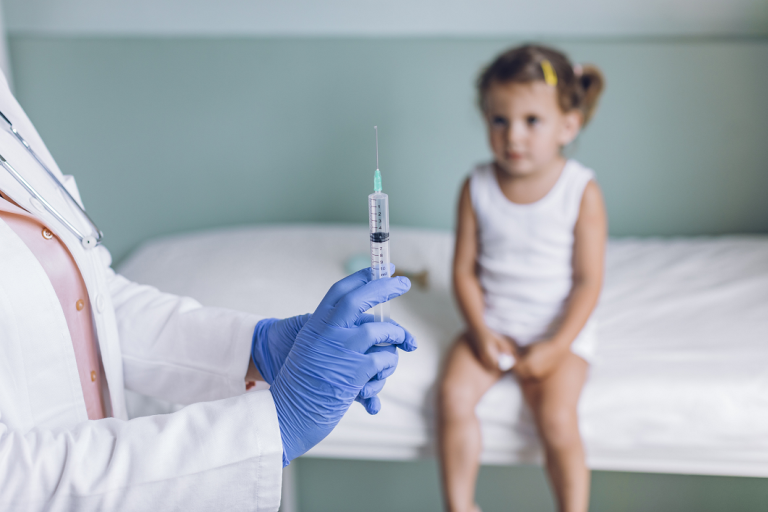Vaccination rates have significantly decreased around the world from pre-COVID-19 pandemic levels, according to a 2023 immunization coverage report released by the World Health Organization (WHO) and UNICEF last month. The report, released on July 14, 2024, is the world’s most extensive dataset on vaccination trends targeting 14 diseases. This report analyzed estimates from 185 countries and used the third dose of the diphtheria, tetanus, and pertussis (DTP3) vaccine—recommended for one-year-olds—as the global benchmark for adequate vaccination coverage.1
According to public health officials, the pandemic marked a “historic backslide” on routine childhood vaccines. Katherine O’Brien, MD, MPH, director of the Department of Immunization, Vaccines, and Biologicals at the WHO, said the current priority is to catch up on vaccinating children who missed their shots during the pandemic and to enhance vaccination coverage to surpass pre-pandemic standards.1
Ninety Percent Global Vaccine Coverage Rate Goal Stalling
The data showed that progress in returning to pre-pandemic vaccination levels has stagnated. In 2022 and 2023, global DTP3 coverage remained at 84 percent, below the 86 percent recorded in 2019. The new report also showed that the number of children who had not received a single dose of DTP3 increased by 600,000 from 2022 to 2023. The authors of the report acknowledged that the findings represent a setback in achieving the Immunization Agenda 2030 goal of 90 percent coverage for routine childhood vaccines. As for the reason rates are stalling, the organizations cited disruptions in health care services, logistical challenges, vaccine hesitancy, and inequities in access to services in a press release.1
Since April 2023, the WHO and UNICEF have collaborated with organizations like Gavi, the Vaccine Alliance and the Bill & Melinda Gates Foundation to further “The Big Catch Up” initiative, a response effort to combat the decline in vaccine coverage following the pandemic.1
The United States saw its highest-ever reported increase in exemption rates last school year. During the 2022-23 school year, exemption rates increased in 41 states, leading to a national rise from 2.6 percent to 3 percent, with 10 states reporting an over five percent increase. Exemptions from school vaccine requirements differ by state. While public health laws in all 50 states provide for medical exemptions granted by a medical doctor or doctor of osteopathy, 45 states and Washington, DC allow religious exemptions. Only 15 states still permit vaccine exemptions for personal, philosophical or conscientious beliefs.2
Wider Distrust of “Authorities, Experts and Industries” During COVID Pandemic
Dr. O’Brien noted that vaccine skepticism, which surged during the pandemic in wealthier countries, is partly to blame for the global decline. She alleged that migrants to wealthier European countries spread “misinformation” back to their home countries. However, Heidi J. Larson, PhD, professor of Anthropology, Risk & Decision Science at the London School of Hygiene & Tropical Medicine, suggested it may be inaccurate to blame “misinformation” for “vaccine hesitancy.” During the 2019 Global Vaccine Summit, Dr. Larson commented, “We have a very wobbly health professional frontline that is starting to question vaccines and the safety of vaccines. [Social media platforms] have a lot of fingers pointing at them to fix the “misinformation” problem,” she said. “The biggest problem is, a lot of it is not misinformation.”1 3 4
Larson continued, “Social media users may pose questions or instill doubt without saying something that is explicitly false. If someone asks, ‘Do you really know what’s in a vaccine?’ we cannot legally or ethically remove it. Getting the balance right between freedom of expression, privacy and public health is a major challenge. The erosion of public trust is part of a wider distrust of authorities, experts and industries.”5
Vaccine Hesitancy a Major Problem in High Income Countries with Educated Populations
A growing body of evidence indicates that wealthier, more informed families embracing holistic or alternative health practices comprise a significant portion of the vaccine-hesitant populations. According to a scientific study examining vaccine hesitancy, vaccine skepticism, which increased significantly during the COVID pandemic, is particularly prevalent among affluent or wealthy families.
The study published in the American Journal of Preventive Medicine concluded that, “There are several studies indicating that vaccine hesitancy is a major problem in high-income countries, where lower rates of vaccine uptake have been found among the wealthiest children.” The survey suggested that the hesitancy stems from greater access to diverse information sources and a tendency towards holistic or alternative health practices. Study authors also speculated that wealthier individuals might also perceive a lower risk of infectious diseases and place a high value on individualism and personal choice, leading to resistance against established medical guidelines and vaccines.6
Pertussis Infections Do Not Exceed Pre-Pandemic Levels Despite Lower Vaccination Uptake
Despite the recent findings of stalled vaccination rates and the U.S. Centers for Disease Control and Prevention’s (CDC) vaccination guidelines that recommend children receive five doses of the DTaP vaccine in their first few years of life, the CDC says that current reported pertussis (whooping cough) cases are not any higher than they were pre-pandemic and that pertussis infections can still occur in vaccinated individuals. While reported pertussis cases have increased in 2024 in the U.S. compared to previous years when reported infection rates dramatically decreased during coronavirus containment measures, such as masking and virtual learning, the CDC considers these current pertussis prevalence numbers a “return to more typical trends.”7
Vending Machine Accidents Result in More Fatalities Annually Than Measles
Ephrem Lemango, MD, associate director for health and global chief of immunization at UNICEF, is concerned about a potential increase in measles outbreaks. The national MMR (mumps, measles, rubella) vaccination rate for U.S. kindergartners was 93 percent last school year, with state MMR coverage rates ranging from 81 percent to 98 percent. This state-to-state variability means that approximately 250,000 kindergartners were not vaccinated for MMR. Still, current overall national vaccine coverage for MMR ranges between 95 percent and 98 percent in the U.S.1 2
Measles, which had already been on a steep decline before the MMR vaccine was introduced in the 1960s, often dominates media reports when an outbreak is reported. This media coverage creates a hostile environment that includes intensified social pressure on and ostracization of unvaccinated individuals. Although 2023 vaccine data suggests that global measles vaccine coverage remains insufficient to prevent circulation of the measles virus and future outbreaks, only 58 measles cases were reported in the U.S. in 2023 and 167 cases were reported in 2024.8
Despite steadily declining MMR vaccination rates for children in the U.S., the last measles-related death occurred in 2015, nearly a decade ago. For comparison, vending machine accidents result in more fatalities annually than measles.9 10
If you would like to receive an e-mail notice of the most recent articles published in The Vaccine Reaction each week, click here.
Click here to view References:2 Kolman S et al. National Conference of State Legislatures. Routine child vaccination rates lower than pre-pandemic levels. State Legislatures News Mar. 23, 2023.
3 Deutsche Welle. Childhood vaccinations stall globally, WHO warns. July 18, 2023.
4 World Health Organization. Global vaccine safety summit. Dec. 2, 2019.
5 European Commission. State of vaccine confidence in the EU 2018. Sept. 12, 2019.
6 Cata-Preta BO et al. Patterns in Wealth-related Inequalities in 86 Low- and Middle-Income Countries: Global Evidence on the Emergence of Vaccine Hesitancy. American journal of preventive medicine. 2021; 60(1): S24–S33.
7 U.S. Centers for Disease Control and Prevention. Pertussis (whooping cough) surveillance and reporting. Apr. 19, 2023.
8 CDC. Measles cases and outbreaks. 2024.
9 CDC. Measles data and statistics. 2023.
10 Doctor-Loeb H. Do Vending Machines Really Kill More Americans Than Sharks Every Year? Slate July 27, 2022.













4 Responses
Great news!
There is no vaccine hesitancy here. We said no to all vaccines. And we meant it. No means no, and does not mean anything else. The state can not force us to take them, and neither can any private company or person. They’re like; How can we adjust our propaganda to get more customers?
Turns out that using force under threat of duress does not sit well with people. Coercion is not consent. Ninety years later, the flue shot still does not work. Why on earth would people think any of the other concoctions are any more effective?
Vaccines are about money. They have very little to do with positive health outcomes. The primary benefit of vaccines to the medical industrial complex; They create a myriad of physiological problems and exacerbate long term disease vectors, leading to an increase of routine customer patronage. More vaccines, chronic illness, more customers. Who’s still buying this? You can not inject health. Real health happens in the kitchen, and the gym.
Good, I’m glad people are waking up. But the flip side of this is that more countries like New Zealand will be mandated to take the jabs, and if they don’t, they will be physically forced to.
So glad to, finally, see people waking up, to this vaccine travesty.